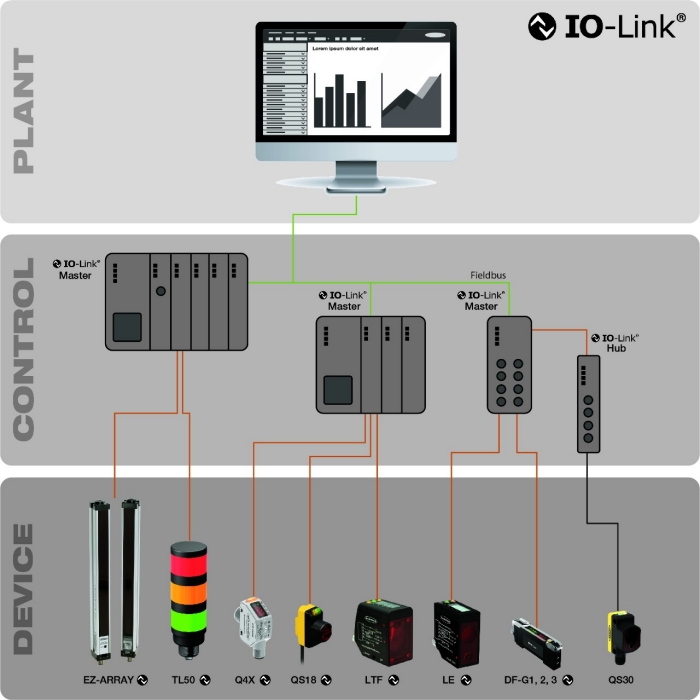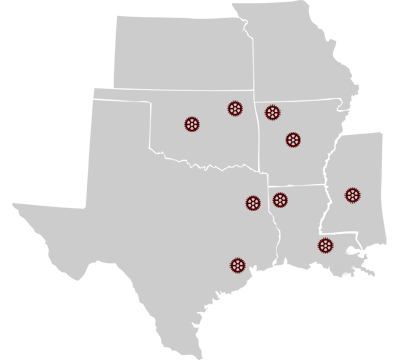What is IO-Link?
An overview of IO-Link technology explains that it is the first standardized IO technology worldwide (IEC 61131-9) for communication with sensors and also actuators. The powerful point-to-point communication is based on the long-established 3-wire sensor and actuator connection without additional requirements regarding the cable material. So, IO-Link is not another fieldbus but the further development of the existing, tried-and-tested connection technology for sensors and actuators.
What can IO-Link do for you?
IO-Link allows remote monitoring capabilities that give you more information about your devices, enabling you to optimize machine performance - helping:
- improve machine availability
- increase efficiency
- reduce costs
A critical benefit of IO-Link for many industries is that IO-Link does not require any special or complicated wiring. Rather, IO-Link devices can be connected using the same cost-effective standard unshielded 3-wire cables as conventional discrete I/O—which helps keep wiring simple.
In addition, IO-Link also eliminates the need for analog sensors and reduces the variety of cord sets required for sensors, which saves inventory costs.
IO-Link also supports a master-slave configuration with passive connection points, which further reduces wiring requirements.
Data availability is a powerful advantage of IO-Link that has far-reaching implications. Access to sensor-level data helps ensure the smooth operation of system components, streamlines device replacement, and enables optimized machine maintenance schedules—all of which save costs and reduce the risk of machine downtime.
There are three primary data types made available via IO-Link communication, which are categorized as either cyclic data (data automatically transmitted on a regular basis) or acyclic data (data transmitted as needed or upon request).
- Process Data refers to the information that the device reads and transmits to the master—such as the distance reading on a laser measurement sensor. Process data can also refer to information that is transmitted to the device from the master (such as messages sent to a tower light indicating which color segments should be illuminated). Process data is transmitted cyclically in a defined data frame. In addition, value status data—indications of whether or not process data is valid—is transmitted along with process data.
- Service Data—also called Device Data—refers to information about the sensor itself such as parameter values, model and serial numbers, device descriptions, etc. Service data can be both written to the device or read from the device acyclically.
- Event Data refers to notifications such as error messages or maintenance warnings (e.g. device overheating, dirty lens) that are transmitted acyclically from the IO-Link device to the master whenever an event occurs.
This wealth of valuable data made available through IO-Link is integral for the Industrial Internet of Things (IIoT) and Industry 4.0 initiatives.
With IO-Link, users can read and change device parameters through the control system software, enabling fast configuration and commissioning that saves time and resources.
Also, IO-Link allows operators to dynamically change the sensor parameters from the control system as needed—such as in the case of product changeover—which reduces downtime and allows machines to accommodate greater product diversity. This is especially important in consumer packaged goods applications where the demand for variety in packaging is continually increasing.
In addition, the ability to monitor sensor outputs, receive real-time status alerts, and adjust settings from virtually anywhere allows users to identify and resolve problems that arise on the sensor level in a timely manner. This also means that users can make decisions based on real-time data from the machine components themselves, which can reduce costly downtime and improve overall efficiencies.
In addition to the ability to remotely adjust sensor settings, IO-Link’s data storage capability also allows for automated parameter reassignment in case of device replacement (this functionality is also known as Auto-Device Replacement or ADR). Users can import existing sensor parameter values into a replacement sensor for seamless replacement, getting the new device up and running as quickly as possible.
IO-Link provides users with visibility into errors and health status from each device. This means that users can see not only what the sensor is doing but also how well it is performing—a valuable insight into a machine’s efficiency.
In addition, extended diagnostics allow users to easily identify when a sensor is malfunctioning and diagnose the problem without shutting down the line or machine.
The combination of both real-time and historic data made available via an IO-Link system not only reduces troubleshooting efforts as issues arise but also allows for optimization of machine maintenance schedules, saving costs and increasing efficiency in the long term.
Optimize your operations, get more from your devices,
and make better, data-driven decisions
with IO-Link solutions from Banner.
https://www.bannerengineering.com/io-link
CONNECT WITH AN IES PRODUCT SPECIALIST
TO PUT THE ADVANTAGES OF IO-LINK TO WORK FOR YOU



